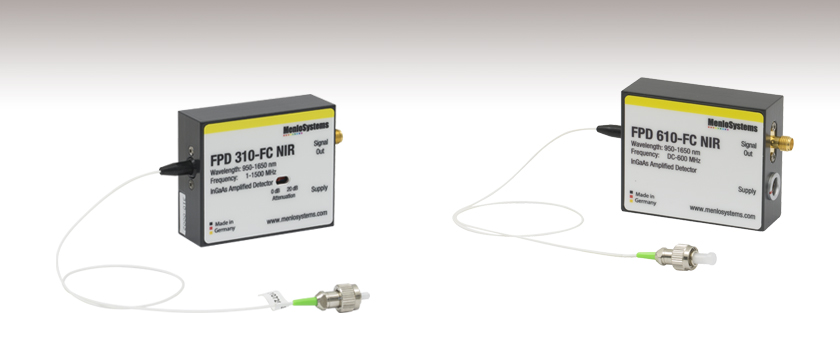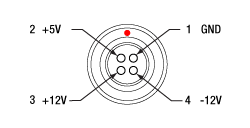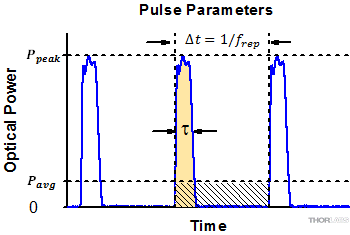InGaAs Fiber-Coupled Amplified Photodetectors

- Wavelength Range from 950 - 1650 nm
- Fixed or Switchable Gain Versions
- Bandwidths Up to 1500 MHz
- High Signal-to-Noise Ratio
FPD610-FC-NIR
Fixed Gain
600 MHz Max Bandwidth
FPD310-FC-NIR
Switchable Gain
1500 MHz Max Bandwidth

Please Wait
Applications
|
| FPD310-FC-NIR |
|
| FPD510-FC-NIR & FPD610-FC-NIR |
|
Features
- Built-in Amplifier
- Fiber-Coupled Module with M4 Tapped Hole for Post Mounting
- Minimum Recommended Load Resistor: 50 Ω
- Power Supply Included
We offer a selection of Indium Gallium Arsenide (InGaAs) Fiber-Coupled Amplified Photodetectors that are sensitive to light in the NIR wavelength range. These fast response detectors are ideal for detection of fast laser pulses, low-light level signals, or chopped light sources. All detectors include a power supply.
FPD310-FC-NIR
Menlo Systems' high-sensitivity, ultrafast PIN FPD310-FC-NIR photodetector is optimized for high gain, high bandwidths, extremely short rise times and high signal-to-noise ratio. The photodetector is an easy-to-use, InGaAs PIN photodiode with an integrated high-gain, low-noise, RF amplifier. The gain can be switched between two fixed settings, which allows optimal performance for many applications. The compact design of this detector allows for easy OEM integration. A low noise power supply with a universal AC input is included. This detector has an SMF28 Pigtail with an FC/APC optical input.
FPD510-FC-NIR & FPD610-FC-NIR
Menlo Systems' high-sensitivity, ultrafast PIN FPD510-FC-NIR and FPD610-FC-NIR photodetectors are optimized for maximum signal-to-noise-ratio for detection of low-level optical beat signals and pulse shapes at frequencies up to 250 MHz and 600 MHz, respectively. These photodetectors are easy-to-use, InGaAs PIN photodiodes with an integrated high-gain, low-noise transimpedance amplifier. The 3 dB bandwidth of these DC-coupled devices is 200 MHz for FPD510-FC-NIR and 500 MHz for FPD610-FC-NIR. The compact design of the detectors allows for easy OEM integration. A low noise power supply with a universal AC input is included with each. The detectors have an SMF28 Pigtail with an FC/APC optical input.
For InGaAs photodetectors with free-space input, click here.
FPD Series Detectors
Signal Out- SMA Female (Photodetector)
For connection to a suitable monitoring device, e.g. oscilloscope or RF-spectrum-analyzer, with 50 Ω impedance.
Female (Power Cables)

Male Power IN (Photodetector)

Pulsed Laser Emission: Power and Energy Calculations
Determining whether emission from a pulsed laser is compatible with a device or application can require referencing parameters that are not supplied by the laser's manufacturer. When this is the case, the necessary parameters can typically be calculated from the available information. Calculating peak pulse power, average power, pulse energy, and related parameters can be necessary to achieve desired outcomes including:
- Protecting biological samples from harm.
- Measuring the pulsed laser emission without damaging photodetectors and other sensors.
- Exciting fluorescence and non-linear effects in materials.
Pulsed laser radiation parameters are illustrated in Figure 1 and described in the table. For quick reference, a list of equations is provided below. The document available for download provides this information, as well as an introduction to pulsed laser emission, an overview of relationships among the different parameters, and guidance for applying the calculations.
|
Equations: |
||||
 |
and |  |
||
 |
||||
 |
||||
 |
||||
Peak power and average power calculated from each other: |
||||
 |
and |  |
||
| Peak power calculated from average power and duty cycle*: | ||||
 |
*Duty cycle ( ) is the fraction of time during which there is laser pulse emission. ) is the fraction of time during which there is laser pulse emission. |
|||

Click to Enlarge
Figure 1: Parameters used to describe pulsed laser emission are indicated in the plot (above) and described in the table (below). Pulse energy (E) is the shaded area under the pulse curve. Pulse energy is, equivalently, the area of the diagonally hashed region.
| Parameter | Symbol | Units | Description | ||
|---|---|---|---|---|---|
| Pulse Energy | E | Joules [J] | A measure of one pulse's total emission, which is the only light emitted by the laser over the entire period. The pulse energy equals the shaded area, which is equivalent to the area covered by diagonal hash marks. | ||
| Period | Δt | Seconds [s] | The amount of time between the start of one pulse and the start of the next. | ||
| Average Power | Pavg | Watts [W] | The height on the optical power axis, if the energy emitted by the pulse were uniformly spread over the entire period. | ||
| Instantaneous Power | P | Watts [W] | The optical power at a single, specific point in time. | ||
| Peak Power | Ppeak | Watts [W] | The maximum instantaneous optical power output by the laser. | ||
| Pulse Width |  |
Seconds [s] | A measure of the time between the beginning and end of the pulse, typically based on the full width half maximum (FWHM) of the pulse shape. Also called pulse duration. | ||
| Repetition Rate | frep | Hertz [Hz] | The frequency with which pulses are emitted. Equal to the reciprocal of the period. | ||
Example Calculation:
Is it safe to use a detector with a specified maximum peak optical input power of 75 mW to measure the following pulsed laser emission?
- Average Power: 1 mW
- Repetition Rate: 85 MHz
- Pulse Width: 10 fs
The energy per pulse:

seems low, but the peak pulse power is:

It is not safe to use the detector to measure this pulsed laser emission, since the peak power of the pulses is >5 orders of magnitude higher than the detector's maximum peak optical input power.
| Posted Comments: | |
CAN FANG
(posted 2024-05-17 05:29:06.623) Dear Thorlabs Support Team,
I hope this message finds you well.
I am writing to bring to your attention an issue that I have encountered with two of our Thorlabs PDA8GS devices. Both units were previously functioning properly, but we recently experienced unexpected behavior with their outputs.
The first unit, when connected to an oscilloscope, consistently outputs -1V regardless of whether there is optical input or not. Similarly, the second unit outputs -1.5V under the same conditions.
We have tried troubleshooting the issue by checking the connections and power supplies, but the problem persists. We would greatly appreciate your guidance on any possible solutions or steps we can take to rectify this problem.
Thank you for your attention to this matter. I look forward to your prompt response and assistance in resolving this issue.
Best regards,
Can Fang ksosnowski
(posted 2024-06-07 02:24:56.0) Hello Can Fang, thanks for reaching out to Thorlabs. The PDA8GS were checked during production to make sure the DC offset was as close to zero as possible. Unfortunately, offsets this large likely mean that the amplifier is damaged. This detector is very sensitive and can easily break if any of the max ratings are exceeded. The amplifier and photodiode pigtail in this detector were a single module which is no longer produced by the OEM and we had to discontinue this detector. We no longer have any modules to replace on damaged units sadly. We recently released RXM15EF as a replacement for this. The RXM15EF also has a fiber-coupled input, transimpedance amplifier, and a higher bandwidth. I have reached out directly to discuss this further. Srikanth G
(posted 2024-01-10 01:35:07.107) May I know minimum bend radius (long term; few years) for the fiber pigtail of FPD610-FC-NIR? ksosnowski
(posted 2024-01-10 01:52:07.0) Hello Srikanth, thanks for contacting Thorlabs. FPD610-FC-NIR uses SMF28 fiber for which the long term bend radius is 16mm for a short length like this detector's pigtail. Sowmendran P
(posted 2023-02-01 21:13:59.35) Hello,
We are reviewing product specification of FPD610-FC-NIR to use for EDFA characterization mesurement in our R&D lab.
Kindly help us clarify following queries,
1> PArameter MAx-Gain menioned is the OE coverrtion gain?
2> Conversion gain mentioned is 2E6v/W does it mean that for every microwatt of optical input change i would get 2v change int he output?
3> Also specification for output signal is menioned as 0~1V does it mean that max output is only 1V? how can we corelate this parameter with conversion gain? ksosnowski
(posted 2023-02-10 12:58:06.0) Thanks for reaching out to Thorlabs. The values listed in V/W are indeed Opto-Electric Conversion Gains. The conversion gain relates input optical power to output electrical power, though the output voltage will saturate at 1V, yielding a nonlinear increase in output with respect to increasing optical input past this point. Saturation can lead to damage on the photodiode/amplifier. I have reached out directly to discuss this further. user
(posted 2021-07-06 22:40:16.943) Hi,
When we turn on the PDA8GS we see a DC voltage of -2.5V on the oscilloscope with 50-ohm termination. What might be the reason for this behavior? The device seems to be working fine when plugged into a spectrum analyzer. YLohia
(posted 2021-08-27 02:45:08.0) Hello, thank you for contacting Thorlabs. It is very strange that you have such a large offset at the oscilloscope. Do you have a terminating resistance at the O-scope or just using the native impedance of the port? What does the signal look like if there is no light incident on the device? is that where you see the large offset? If you switch to Hi-Z coupling on your O-scope does anything change? What kind of spectrum analyzer are you using? Is this a brand new PDA8GS? user
(posted 2019-05-09 13:43:00.173) I have similar question that was posed to ThorLabs in past. Generally the detectors with GHz response have lower frequency cut-off of few 10s of kHz. Also AC coupled versions do not detect CW component. PDA8GS seems to be an exception. Can PDA8GS display DC and few kHz pulse trains (with pulses of slow rise /fall times few ns) without distortion? If a signal has DC and AC components, Can PDA8GS be used detect pulsed signal and its DC background (CW component)?
Below is similar question from past from someone else for your ready reference.
-Srikanth
kedves (posted 2017-05-11 15:07:06.75)
Dear Thorlabs, let me inquire about the frequency characteristics of PDA8GS. Is the transfer function over the whole frequency range DC-9.5 GHz smooth? I am asking this because we have fast amplified photoreceivers of another manufacturer which have a crossover region (at about 25-100 KHz) between the DC and AC responses leading to a distorted output signal to e.g. a step function input. What is the response of this detector to a step function? Is there any visible transition between the DC and high frequency ranges? Thanks
nbayconich (posted 2017-06-07 05:03:14.0)
Thank you for contacting Thorlabs. We are currently looking into measuring the bandwidth frequency characteristics of the PDA8GS. A techsupport representative will contact you directly with more information. asundararaj
(posted 2019-05-09 07:27:47.0) Thank you for contacting Thorlabs. The PDA8GS is a DC coupled detector and hence, it can detect both CW and and ~kHz pulsed components of the signal. I have contacted you directly via email to discuss this further. minowa
(posted 2018-09-24 06:14:47.367) Hi, could you provide the information about the NEP of PDA8GS? YLohia
(posted 2018-09-24 01:17:12.0) Hello, thank you for contacting Thorlabs. The dark current, at 25°C, is typically <10nA, and at 55°C is typically <50nA. The NEP for the fiber-optic receiver is:
NEP (rms)
1.5uW typical @ 1310nm
3.0uW maximum @ 1310nm
2.5uW typical @ 850nm
5.0uW maximum @ 850nm
Recently, we performed a preliminary test with 1550nm, and found that the input referred noise = 1.5uW rms (with 9.5GHz bandwidth).
Assuming a white noise distribution over the 9.5GHz bandwidth, this implies NEP = 15pW/rt-Hz. These numbers then scale inversely with responsivity at other wavelengths.
Please note that this only sample data and is not necessarily representative of our current units. These values presented are not a guaranteed performance. kedves
(posted 2017-05-11 15:07:06.75) Dear Thorlabs, let me inquire about the frequency characteristics of PDA8GS. Is the transfer function over the whole frequency range DC-9.5 GHz smooth? I am asking this because we have fast amplified photoreceivers of another manufacturer which have a crossover region (at about 25-100 KHz) between the DC and AC responses leading to a distorted output signal to e.g. a step function input. What is the response of this detector to a step function? Is there any visible transition between the DC and high frequency ranges? Thanks nbayconich
(posted 2017-06-07 05:03:14.0) Thank you for contacting Thorlabs. We are currently looking into measuring the bandwidth frequency characteristics of the PDA8GS. A techsupport representative will contact you directly with more information. makarov
(posted 2016-05-26 14:11:44.267) PDA8GS actually dies if the optical power rating is exceeded. This was a surprise to us. The maximum rating is 1 mW CW. We did not pay attention initially, because we thought the front-end photodied surely takes much more that 1 mW to get physically damaged, and what else could go wrong? It has turned out, the RF amplifier dies. Our units just came back from a lengthy and costly repair. I with it were stated in the spec sheet that damage to the RF amplifier will result from exceeding the optical power.
We have similar amplified photodetectors from LeCroy (OE455/555) and they do not die from optical overload, even though they get saturated at less than 1 mW just as this Thorlabs photodetector. besembeson
(posted 2016-06-01 05:33:43.0) Response from Bweh at Thorlabs USA: This is actually a failure of the sensor material itself. To operate at these high speeds, the active area needs to be very small since the photodiode capacitance is directly correlated to active area. This is the limiting factor for electrical bandwidth. In this case, the fiber inserts against a ball lens that focuses all the light onto this very small active area sensor. The material damage threshold can easily be exceeded. Usually it looks like a very large dark current to the electronics where the gain is usually enough to saturate the output to the voltage rail. Since this is an integrated PD and amplifier package, the complete module needs to be replaced as a result of this - reason for the repair being more expensive than imagined. |
 Products Home
Products Home












 InGaAs Fiber-Coupled Amplified Photodetectors
InGaAs Fiber-Coupled Amplified Photodetectors